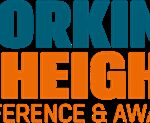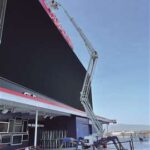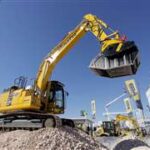Scissor lifts are essential tools in a variety of industries, including construction and warehousing, providing workers with a safe and stable platform to reach elevated areas. These lifts, with their spacious platforms, are designed to safely support both workers and their equipment. However, as with any heavy machinery, there are potential risks involved. Proper safety training, including adherence to OSHA guidelines, is crucial to minimize accidents and ensure workers’ safety while using scissor lifts.
What Is a Scissor Lift?
A scissor lift is a motorized platform capable of vertically raising workers to reach high areas. It features crisscrossing metal supports and a platform mounted on folding arms, which allow for its distinct movement. Scissor lifts can be powered either by gasoline or electricity and come in various sizes, making them suitable for a wide range of applications. These lifts are considered a type of scaffolding by OSHA, rather than a traditional aerial lift, offering an advantage in mobility compared to standard scaffolds.
Key Safety Tips for Scissor Lifts
Safety is paramount when using a scissor lift. Here are some critical safety rules and practices to follow:
-
Fall Protection
Ensuring that workers are protected from falls is one of the most important aspects of scissor lift safety. While scissor lifts must be equipped with functional guardrails to prevent falls, safety harnesses may also be required depending on company policies and job conditions.- Always ensure the lift is equipped with sturdy guardrails.
- Never allow workers to stand on guardrails.
- Workers should not operate the lift alone and must avoid leaning away from the lift.
- If a harness is required, it must be used correctly to prevent accidents.
-
Stabilization
Maintaining stability is crucial to prevent the lift from tipping over. Here are some tips to enhance stability:- Position the scissor lift on firm, level ground and avoid placing it near drop-offs or on uneven surfaces.
- Ensure that the lift is not in proximity to heavy traffic or other equipment that might make contact.
- Avoid using the lift in poor weather conditions, such as high winds, which could affect its stability.
- Always adhere to the manufacturer’s weight and height limits to avoid overloading the lift.
-
Positioning the Scissor Lift
Proper positioning of the lift is essential to avoid crushing or electrocution hazards. Follow these positioning guidelines to ensure safety:- Maintain a distance of at least 10 feet from power lines to reduce the risk of electrocution.
- Use traffic control methods to ensure that the work area around the scissor lift is free from other workers and vehicles.
- Make sure that the lift’s platform is clear of any overhead obstacles, including power lines and fixed structures.
-
Maintenance and Inspections
Regular maintenance is essential for safe scissor lift operation. A lift that is not well-maintained can pose serious risks. Here’s how to maintain the equipment:- Conduct pre-inspections before use to check for any damage or faulty components.
- Ensure safety systems are operational, and check that guardrails are in good condition.
- Regularly test the emergency stop buttons and brakes to ensure the lift can be safely stopped at any time.
-
Training for Operators
OSHA mandates that scissor lift operators receive proper training before using the equipment. Training should cover the following:- Understanding the manufacturer’s guidelines for safe operation.
- Recognizing potential hazards on the worksite and how to mitigate them.
- Learning the proper procedures for handling materials and adhering to weight limitations.
- Reporting defects and maintenance issues promptly.
Common Scissor Lift Safety Hazards
Despite their reliability, scissor lifts pose several potential safety hazards:
- Poor Maintenance: Lack of regular inspections or improper maintenance can cause performance issues, leading to accidents.
- Improper Positioning: Positioning the lift too close to overhead power lines or fixed objects can lead to electrocution or crushing injuries.
- Insufficient Training: Operators who are not adequately trained are more likely to make mistakes, increasing the risk of accidents.
The Major Causes of Scissor Lift Accidents
Accidents often occur when scissor lift safety protocols are ignored. Some common causes of accidents include:
- Stability issues during operation.
- Improper positioning or inadequate guarding.
- Operating the lift in bad weather conditions.
- Malfunctioning safety features.
Improving Safety Through Certification Training
One of the most effective ways to prevent accidents and injuries is to provide proper training and certification for scissor lift operators. OSHA certification ensures that operators are fully equipped to handle the lift safely and understand the potential hazards associated with its use. CertifyMeOnline.net offers online OSHA-compliant scissor lift training courses that can be completed in under an hour, ensuring your workforce stays safe and compliant.




